2. 西南大学 材料与能源学部, 重庆 400715
2. Faculty of Materials and Energy, Southwest University, Chongqing 400715, P. R. China
镁合金是工业应用中最轻的金属材料之一,被称为绿色工程材料,具有低密度和高比强度等突出优点,在多种领域中有重要的应用价值和广阔的应用前景,已成为目前的研究热点之一。镁属于密排六方(HCP)结构,室温条件下独立的滑移系少,塑性变形能力差,加工成形困难,严重制约了镁合金的应用及推广。研究发现,合金设计[4-5]和工艺优化[6]等方法可有效地解决这些问题。这些研究方法大多是通过实验手段对相关影响因素进行分析,然而,采用传统的实验方法探究材料的微观机理十分受限,且外界干扰因素较多。近年来,各种模拟计算技术的发展促进了微观层次上的材料强韧化机理研究,实现了联系理论与实验的桥梁作用。其中,第一性原理计算是目前广泛应用于镁合金的计算模拟方法。基于密度泛函理论的第一性原理计算是利用量子力学[7-8]的算法,该体系是自洽且完备的,具有很好的移植性。因此,在材料科学领域,第一性原理有其他方法无法比拟的优势,它能够使模拟体系的性质与特征接近真实情况,甚至可以模拟实验无法实现的工作。一方面,第一性原理计算方法的应用有助于在微观层面上对镁合金进行深入研究;另一方面,传统的材料研发模式是以实验为主的“试错法”,研发周期长且效率低,从最初发现新材料到最终工业化应用一般需要10~20年的时间。模拟计算方法作为加速新材料研发的重要手段之一,能够将材料的结构、组成和性能有效结合,从而在一定程度上预测材料的性能。综上所述,利用第一性原理计算方法进行元素替代、结构筛选和性能优化等,对深入镁合金的理论研究以及加快先进镁合金的开发和应用显得尤为迫切和重要。笔者基于第一性原理研究方法,从镁合金的晶体结构、弹性常数、弹性模量及广义层错能等方面出发,综述了镁合金合金相及固溶体的研究进展,讨论了合金元素及相结构对镁合金力学性能的影响。希望借此阐明第一性原理计算方法在镁合金研究中的重要作用,为新型镁合金成分设计及开发高性能镁合金提供有力的理论依据。
1 理论基础量子力学是现代物理的基础,其最普遍的表达形式即为薛定谔方程,它描述了粒子的波函数及运动方程。基于量子力学的第一性原理可以不依赖任何经验和半经验的参数直接求解薛定谔方程,从而准确得到材料的电子结构,获得体系的物理化学性质。然而,由于电子和原子核的相互作用难以分离,要处理多电子的复杂体系时,求解薛定谔方程就显得尤为困难。为了解决这一问题,Born-Oppenheimer提出了绝热近似(BO近似)。原子核质量远大于电子质量,一般为3~4个数量级,因而在同样的相互作用下,根据动量守恒,原子核运动比电子运动慢得多。BO近似将原子核和电子的运动分开处理,处理电子运动时假定原子核固定于瞬间位置上,而处理原子核运动时则假定快速运动的电子建立了一个平均化了的负电荷分布。即便如此简化后,多体问题仍然阻碍着求解薛定谔方程。研究者在此基础上引入了单电子近似,即假设电子之间没有任何相互作用,则体系内多电子波函数就可以转化为单电子波函数的简单乘积。而Thomas-Femi模型曾表明在均匀电子气模型中,电子不受任何外力,彼此没有相互作用,从而描述电子运动的薛定谔方程就被简化为波动方程。Hohenberg和Kohn以此为基础,打破了能量泛函形式的束缚,创立了著名的密度泛函理论(density functional theory,DFT)。该理论证明了体系的基态能量只与电荷密度有关,是电荷密度的泛函,并且以基态密度为变量,将体系能量最小化就得到了基态能量。Kohn-Sham方程进一步用自洽等价的单电子方程解决了多电子问题,为后来的第一性原理分析提供了框架,使密度泛函理论得到实际应用。图 1说明了基于密度泛函理论的第一性原理计算的由来。此后,计算的复杂问题转移到了如何精确交换关联泛函的表达式上,寻找更精确和普适性的交换关联泛函成为现代密度泛函方法发展的主线。
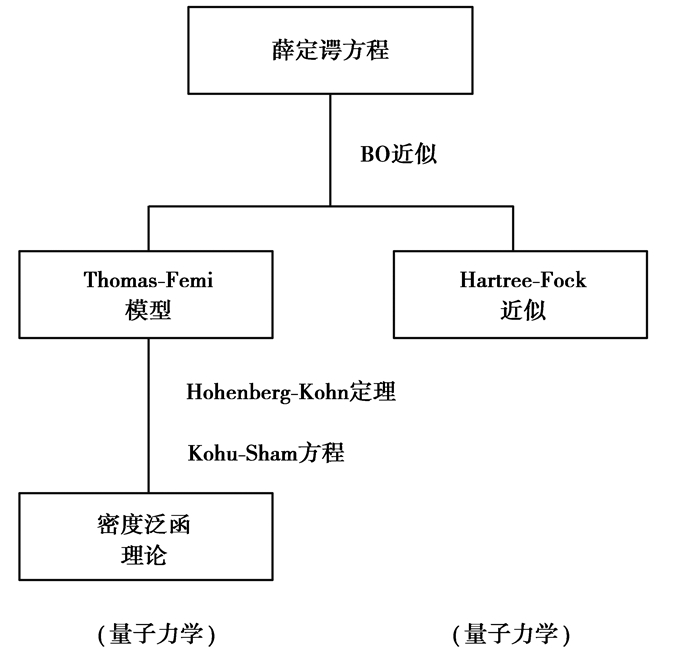
|
图 1 基于密度泛函理论的第一性原理计算的由来 Figure 1 The origin of the first-principles calculation with density functional theory |
晶格常数作为晶体结构的一个基本参数,反映了晶体内部成分和结构状态等,是材料结构研究的基础。在镁合金的第一性原理计算中,晶格常数通常被视为验证模型建立和参数设定是否合理可靠的依据,是进行深入计算的基础。目前,运用第一性原理方法计算合金相的晶格常数已十分成熟。镁合金相的晶格常数计算可归为三类,分别为二元合金体系中不同结构的金属间化合物、多元合金体系中各种金属间化合物以及特定构型的金属间化合物。例如,对Mg与Ⅲ-ⅥA族元素[9-19]B、Al、Ga、Si、Ge、Sn、Pb、As、Sb、S、Se、Te,碱土金属元素[20-22]Ca、Sr、Ba,稀土元素[13, 23-29]Y、La、Ce、Nd、Gd、Tb、Dy、Lu以及其他元素[13, 22, 30, 31]Li、Ni、Cu、Zn、Cd等形成的二元合金体系中不同结构合金相的晶格常数计算;对多元合金体系Mg-Ca-Sr[21]、Mg-Al-Ca[32]、Mg-Sc-Zn[33]、Mg-Al-Sr[34-35]、Mg-Al-Ca-Sn[36]、Mg-Zn-Ca-Cu[37]、Mg-Zn-Re-Zr[38]中各种二元合金相的晶格常数计算;对B1结构(NaCl型)Mg-Se[39]、B2结构(CsCl型)Mg-RE[40-43]和Laves结构的Mg-Ca[44-45]、MgxAl4-xSn[46]等特定构型合金相的晶格常数计算。图 2为含不同稀土元素的立方结构MgRE晶格常数a的计算结果,可以发现,MgEu具有最大的晶格常数,MgSc的晶格常数最小,MgRE晶格常数随RE原子序数增加大致呈现出减小的趋势。此外,研究者还对镁合金金属间化合物的晶格常数随温度和压力的变化情况进行了研究。研究[47-49]表明,晶格常数随温度升高而增大,随压力增大而减小。
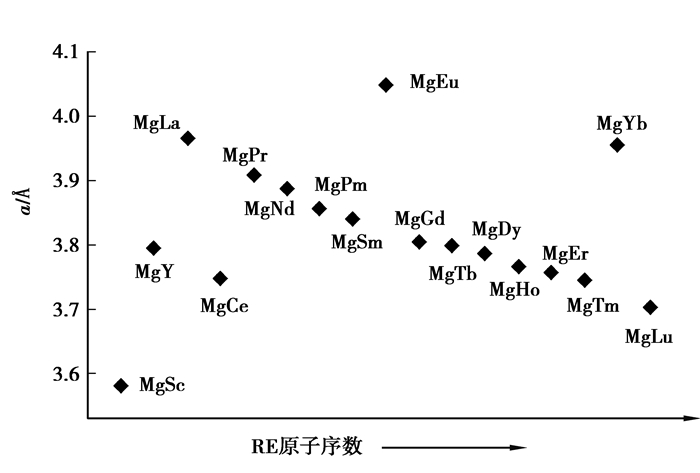
|
图 2 立方结构MgRE的晶格常数 Figure 2 Lattice constants of cubic MgRE |
合金相可通过析出强化来改善镁合金的力学性能,因此,对合金相弹性常数的研究有助于了解镁合金宏观力学性能。固体材料的弹性常数可以提供力学性能方面的性质,特别是对于材料的稳定性和刚度而言[50]。在第一性原理计算中,单晶体的弹性常数可以通过晶胞总能量与晶格变形的函数关系得到。根据晶体对称和晶格变形的类型,总能量与应变曲线的曲率可以定义一个特定的弹性常数或一个弹性常数的组合。线性弹性常数构成一个6×6的对称矩阵,包括27个不同的分量,各向异性材料中有21个独立的弹性常数,而各向同性材料只有2个独立的弹性常数。如果引入了材料的对称性,那么必须减少独立弹性常数的数量,从而计算出完整的弹性常数集。对于正交晶系,弹性张量具有9个独立的分量,正方晶系具有6个独立弹性常数,六方晶系和立方晶系的独立弹性常数分别为5个和3个。因此,合金相的弹性常数与晶体结构息息相关。Luo等[51]计算了新型层状结构La2Mg17的弹性常数,不同于普通的层状结构,六方结构La2Mg17的轴比c/a<1,因此,其弹性常数也会有所不同。由于较弱的层间结合力,通常C33是小于C11的,而计算得到La2Mg17的弹性常数C33大于C11。除了晶体结构的影响,弹性常数还与温度以及压力有关,随温度的升高而减小[42],随压力的增大而增大[49, 52, 53]。进一步,Sahraoui等[39]研究MgSe的性质时,发现其弹性常数与压力呈现出线性关系。
在获得弹性常数后,需要进一步检查晶体结构的力学稳定性。根据应变能理论,力学稳定的相,其应变能和弹性常数应该是正数,且弹性常数是确定和对称的,因此,弹性常数还需满足Born力学稳定性的条件。对于不同结构的晶格体系,力学稳定性的判断标准有所不同。
对于立方晶系,弹性常数需要分别满足以下要求[54]:
| $ {C_{11}} > 0, {C_{11}}-{C_{12}} > 0, {C_{44}} > 0, {C_{12}} > 0。$ | (1) |
正方晶系的力学稳定性判据[55]为:
| $ {C_{11}} > 0, {C_{33}} > 0, {C_{44}} > 0, {C_{66}} > 0, {C_{11}}-{C_{12}} > 0,\\ {C_{11}} + {C_{33}}-2{C_{13}} > 0, 2{C_{11}} + {C_{33}} + 2{C_{12}} + 4{C_{13}} > 0。$ | (2) |
六方晶系只有5个独立的弹性常数,包括C11、C12、C13、C33和C44,其中C66=(C11-C12)/2,其对应的条件[56]为:
| $ {C_{11}} > |{C_{12}}|, {C_{44}} > 0, ({C_{11}} + 2{C_{12}}){C_{33}} > 2C_{13}^2。$ | (3) |
正交晶系需满足的力学稳定性判据[56]如下:
| $ \begin{array}{l} {C_{11}} > 0, {C_{22}} > 0, {C_{33}} > 0, {C_{44}} > 0, {C_{55}} > 0, {C_{66}} > 0, \\ [{C_{11}} + {C_{12}} + {C_{33}} + 2({C_{12}} + {C_{13}} + {C_{23}})] > 0, \\ {\rm{ }}{C_{11}} + {C_{22}} -2{C_{12}} > 0, {C_{11}} + {C_{33}} -2{C_{13}} > 0, \\ {C_{22}} + {C_{33}} -2{C_{23}} > 0。\end{array} $ | (4) |
研究者们已成功计算了许多镁合金相的弹性常数,例如Mg17Al12[11]、Mg2Ca[19]、Mg2Ni[22]、MgZn2[33]、MgCu2[37]、Mg2Ge[15]、Mg3As2[18]、Mg2Sr[34]和MgRE[40]等。以上金属间化合物的弹性常数理论计算值在表 1中给出,所计算的弹性常数均满足力学稳定性判据,即所研究的合金相均是力学稳定的结构。另外,计算得到的弹性常数与其他理论值及实验结果吻合较好。从表中可以看出,MgPd3的弹性常数相当大,这与它的高熔点和内聚能有关;Mg2Ba的弹性常数较小则表明其具有弱结合特性。此外,合金相的弹性常数C33和C11通常大于其他弹性常数,这是因为弹性常数C33和C11分别反映了合金相沿着a和c方向的线性压缩阻力,意味着合金相在沿着a轴和c轴的单轴应力作用下具有较大的不可压缩性[57]。另外,弹性常数C44是一个非常重要的参数,它与材料的剪切模量有关,C44越大表明在(001)面上具有较大的抗剪切变形能力[58]。从表中数据可知,合金相的C44基本都在10~50 GPa的范围内,表明这些合金相在(001)面上的抗剪切变形能力较弱。
| 表 1 镁合金金属间化合物的弹性常数、体积模量(B)、剪切模量(G)和杨氏模量(G)的第一性原理计算值 Table 1 The calculated elastic constants, Bulk modulus (B), Shear modulus (G) and Young's modulus (E) for intermetallic compound in Mg alloys |
对于多晶材料,弹性模量比弹性常数具有更实际的应用价值。根据弹性常数,可以推导得到相应的体积模量B、剪切模量G、杨氏模量E、泊松比γ和各向剪切异性因子A。体积模量通常被认为是材料在承受外力时对体积变化的阻力。体积模量越大表明承受外力时材料对体积变化具有更强的抵抗力。Wu等[46]计算了laves相Mg(Cu1-xZnx)2(x=0,0.25,0.5,0.75)的弹性模量,结果显示,合金的体积模量随着Zn含量的增加迅速减小。由于体积模量决定了材料的不可压缩性,因此,Zn含量增加会降低Mg(Cu1-xZnx)2的不可压缩性。剪切模量表示材料承受剪切应力时抵抗可逆变形的能力。如果剪切模量越大,则表明原子间的定向键合越显著。Luo等[51]发现La2Mg17的体积模量、剪切模量均高于其他高La含量的Mg-La合金,表明其中存在更强的共价键。在Mg-Al-Ca合金体系中,计算结果显示Mg2Ca的体积模量最小,其次是MgAl2,最后是Al2Ca,而剪切模量的关系为CaAl2>MgAl2>Mg2Ca[59]。Mg-Al-Sr体系中合金相的计算结果表明,Mg17Al12具有最大的剪切模量,其余依次是Al2Sr、Al4Sr、Mg17Sr2、MgSr和Mg2Sr,因此,Mg17Al12的定向键合最强,且Mg17Al12的抗变形能力要比其他合金相强得多[34]。杨氏模量是衡量材料刚度的物理量,杨氏模量越大,材料就越硬。图 3为部分镁合金相杨氏模量的计算值,由图可以看出,不同合金相的杨氏模量差异巨大。MgPd3的杨氏模量最大,则硬度最大;MgYb的杨氏模量最小,则硬度最小;MgRE的杨氏模量基本接近。Yang等[60]对比MgxAl4-xSr的杨氏模量,得出Mg2Al6Sr2的硬度最大,MgAl7Sr2次之,Mg4Sr最后。泊松比是用来量化晶体材料抵抗剪切变形的稳定性的物理量,其值通常在-1~0.5的范围内,泊松比越大,材料的可塑性就越好。例如,在Mg-Al-Ca-Sn合金中,Mg2Sn的泊松比最大,因此,具有最大的塑性,接着依次是Mg2Ca、Mg17Al12和Al2Ca[36]。
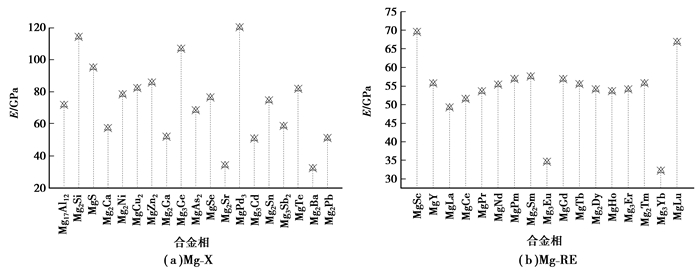
|
图 3 镁合金相的杨氏模量 Figure 3 Young's module of Mg based compounds based on elastic properties |
弹性模量及泊松比能够在一定程度上反映合金相的力学性能,但为了对合金相的力学性能有更好的理解,可将其键合特性和韧性联系起来。金属间化合物的键合特性可以用Cauchy压力来反映。Cauchy压力越正的化合物更倾向于形成金属键,Cauchy压力越负则更倾向于形成不对称的化学键。立方结构化合物的Cauchy压力用弹性常数(C12-C44)表示,正方和六方结构用弹性常数(C12-C66;C13-C44)表示,斜方结构用弹性常数(C12-C66;C13-C55;C23-C44)表示。研究表明,化合物的脆韧性与Cauchy压力有关,韧性越好的化合物其金属键越强。图 4给出了几种立方结构镁合金相的Cauchy压力,MgCu2的值为正,且显著高于其他合金相,表明MgCu2更倾向于形成金属键,韧性更好;Mg2Ge的值最负,表明Mg2Ge更倾向形成不对称的化学键。此外,研究[61]发现弹性常数(C11-C12)可以作为评判材料力学性能的重要指标。弹性常数(C11-C12)的值越小,则表明杨氏模量越低,材料的塑性就会越好。Zhou等[15]计算了Mg2X(X=Si,Ge,Sn,Pb)的弹性常数(C11-C12)值和杨氏模量,其中,Mg2Pb的(C11-C12)值和杨氏模量最小,即具有最佳的塑性。除此之外,Pugh[62]提出剪切模量与体积模量的比值B/G也可以反映金属材料的脆韧性,B/G值越大,则金属的韧性越好。区分材料是否为韧性或者脆性的临界值为1.75,若材料的B/G>1.75,则说明其具有韧性。据文献报道[11, 15, 16, 18, 19, 22, 33, 34, 37, 40, 45]可知,大部分合金相都呈现出韧性的特征,如图 5所示。然而,Counts等[63]认为对于材料的力学性质判定,Pugh判据中的临界值不应该被视为一个决定性的转折点,因为其根本标准太过简单,无法全面考虑到材料脆韧性转变的复杂性。由此,Counts等提出了特定模量的定义,即杨氏模量与密度的比值,该参数结合了现有的力学性质判据,将有助于超轻材料的设计和应用。此外,晶体材料的各向异性在工程应用中具有重要的意义,各向异性越小则金属材料的加工变形性能越好。Wu等[33]得出在{101 0}和{011 0}面上,MgZn2比ScZn2具有更高的各向异性,而MgZn2与ScZn2在{0001}面上具有各向同性,表明这两种合金相的各向异性符合HCP结构的一般性质。Dai等[64]研究了合金元素(Ca, Mn, Ni, Cu, Zn, Zr, Sn, La)以及氧掺杂对Mg17Al12各向异性的影响。结果表明,Ca、Zr和La倾向于置换Mg原子,N、Cu和Zn偏向于取代Al的位置,Mn和Sn不能稳定存在于Mg17Al12中,O倾向于占据间隙位置。合金元素周围产生了局部变形,因此,合金化增加了Mg17Al12的弹性各向异性。而合金元素与氧同时掺杂时,能使Mg17Al12的各向异性减弱,分析认为这可能与氧原子的对称分布有关。
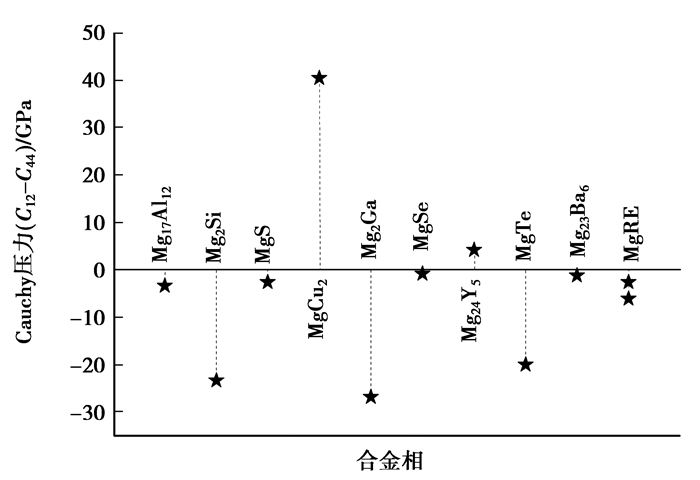
|
图 4 立方结构镁合金相的Cauchy压力 Figure 4 Cauchy pressure for cubic Mg compounds |
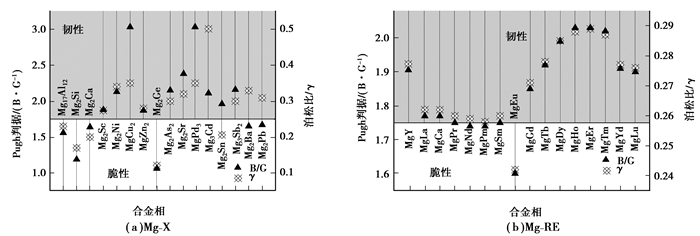
|
图 5 镁合金相的韧脆性 Figure 5 Ductile/brittle properties of Mg based compounds based on elastic properties |
金属材料的塑性变形主要是通过位错运动实现的,因此,塑性变形与晶体内的位错特征密切相关,而位错特征通常取决于材料的晶体结构。纯镁及绝大部分镁合金均具有HCP结构,其轴比c/a为1.623。King等[65]首次利用第一性原理方法计算了Mg的晶格常数以及c/a值。Smith[66]采用不同的赝势计算了镁的晶格常数及c/a值,如表 2所示,相较于局部密度近似(local-density approximation,LDA),广义梯度近似(generalized gradient approximation,GGA)的精度更接近于实验值。Wang等[27]进一步指出,GGA/PBE和GGA/PW91的精度与PW91相似,考虑到研究体系具有大量原子时,选择GGA/PW91作为结构优化和能量计算的交换关联函数,对结果准确性的影响更小。
| 表 2 Mg晶格常数计算值与实验值比较[66] Table 2 Comparison of calculated lattice constants with experimental values[66] |
在镁中掺杂合金元素形成置换固溶体时,由于原子尺寸的差异,会引起晶格畸变,即改变了合金的晶格常数及轴比。有观点认为,降低c/a值可以提高晶格对称性,使柱面滑移系被激活,从而在一定程度上改善镁合金的塑性。研究[67-68]指出,原子半径、原子堆积方式以及掺杂原子种类和含量均会对镁合金固溶体的晶格常数产生影响。图 6为部分Mg-X固溶体的晶格常数计算值,可以看出,掺杂原子对镁晶格常数的影响符合固溶置换理论,即尺寸较小的掺杂原子使镁晶格收缩,尺寸较大的掺杂原子使晶格膨胀。并且,随着原子半径增大,Mg-X固溶体的晶格常数呈现增大的趋势。有趣的是,掺杂原子对c/a值的影响与原子半径没有明显关系,其中,Ni、Cu和Ba能够显著降低镁的轴比,进一步的研究[69]指出,镁合金中掺杂Y元素形成固溶体后,晶格常数增大的同时,固溶体的c/a值明显降低,并且c/a值随着Y含量呈现“V”型的减小趋势,Y含量为0.5 at.%时固溶体的轴比达到最小值,由此说明,Y元素能有效降低镁合金的轴比。此外,在Mg1-xZnx合金中,随着Zn浓度增大,晶格常数c和a均有所减小。掺杂Zn之后的c/a值小于纯镁,随着Zn含量升高,c/a值升高,甚至超过纯镁[70]。

|
图 6 Mg-X固溶体合金的晶格常数[67] Figure 6 Lattice constants of solid solution Mg-X alloys |
相较于合金相而言,镁合金基体的弹性模量对于材料力学性能的影响不可忽视。因此,了解合金元素对镁合金固溶体弹性模量的影响也十分必要。Dai等[71]指出,合金元素的种类对镁合金掺杂体系的弹性常数C13和C44有较大影响,并且弹性常数(C11-C12)对合金元素也非常敏感。Oleg等[72]研究了合金元素Ca、Zn、Li、Zr、Y、Sc、Mn、Ag对镁弹性模量的影响。此外,合金原子的价电子会影响合金的体积模量,甚至Mg-X合金的弹性模量强烈依赖于合金原子的弹性模量。合金元素的含量也会影响镁合金固溶体的弹性模量。Peng等[69]根据不同Y含量对镁合金固溶体杨氏模量的影响,建立了Y含量与杨氏模量的函数关系。Mg-Y固溶体的杨氏模量随着Y含量的增加而增加,并且具有以下线性关系:E=0.67CY+44.8(CY为Y浓度)。而时效过程中,合金的杨氏模量主要与第二相的百分含量及固溶体中的Y含量有关,225 ℃下时效态Mg-Y合金(含有共晶相Mg24Y5)的杨氏模量计算公式为E=44.8+0.67C0+49.78Vf(C0为Mg24Y5开始析出时的Y含量,Vf为Mg24Y5的体积百分含量)。此外,特殊的晶体结构对弹性模量具有一定贡献,如长周期堆垛有序(LPSO)结构的Mg-Zn-Y合金的杨氏模量和剪切模量都明显高于纯镁,并且,其沿着[0001]方向的杨氏模量比[11 20]的高。Tane等[73-74]认为,Mg-Zn-Y合金中,短程有序固溶原子团簇的形成焓和LPSO相的堆垛顺序对由层间原子键决定的弹性模量有很大影响。
3.3 广义层错能HCP结构的镁及镁合金,其理想完整的晶体结构是由基面按ABABABAB…的次序堆垛而成。而实际晶体中,原子并非总是按理想规则排列,而是可能出现错排并在出现错排的位置形成一个层错。层错作为高密度的面缺陷,具有增大材料强度和延性的巨大潜力。层错的形成会导致系统能量增加,形成单位面积层错所增加的能量称为层错能。1968年,Ravindran等[75]提出了广义层错能的概念。Wu等[76]计算了几种HCP结构金属的基面广义层错能,发现广义层错能对HCP金属的原始晶胞和c/a值非常敏感,因此,得出原始晶胞体积和c/a值是确定HCP金属广义层错能的两个关键参数。层错类型不同时相应的层错能也会存在差异。Smith[66]研究了纯镁基面的本征层错(Ⅰ1和Ⅰ2型)、插入型层错(E型)和对称型层错(T2型),并对基面、柱面和锥面的广义层错能进行了计算。结果表明,对于基面层错,Ⅰ1型本征层错的层错能最低,其次为Ⅰ2型本征层错和T2型层错,最后为E型层错;此外,柱面和锥面的广义层错能远高于基面广义层错能。研究表明,LPSO结构的材料具有优良的力学性能。Fan等[77]研究了纯镁的LPSO特征的多层错结构(包括6H, 10H, 14H, 18R和24R),详细分析了LPSO特征的多层错结构与基面层错结构的关系。此外,LPSO结构和相同类型的层错会发生相互转化,平均层错能更低差异更小的更容易发生相互转化。Li等[78]在对广义层错能计算的基础上,得到了纯镁中几种LPSO结构之间的最佳转化路径。
合金元素的种类以及掺杂量均对广义层错能有所影响。例如,Al有利于基面连续层错的发生,这是由于合金元素与镁形成不同的键合类型导致的,而不仅仅是由于掺杂原子尺寸影响的[79]。研究表明,Al、Sn和Pb可以减小镁合金的非基面广义层错能,对改善镁合金的塑性有利[80-81]。Yasi等[82]发现K、Na、Sc、Y和Zr能使柱面的广义层错能减小从而产生明显的软化效果。Li能够促进镁合金的位错协调过程,增加沿层错路径的层错能,其对基面层错能的增加程度远高于柱面,使得合金具有更低的交滑移应力。此外,Zn和Y对基面本征层错能的影响效果是相反的,但是,同时掺杂Zn和Y会显著降低镁合金的层错能[83]。关于合金元素掺杂量,Sandlöbes等[84]发现镁合金的I1型层错能随着Y含量增加而下降,提出了Mg-Y固溶体合金中位错从基面滑移到锥面滑移的重要机制,即I1型本征层错作为<c+a>位错的异质源,可加强<c+a>位错形核,促进<c+a>滑移,提升镁合金塑性。有研究者认为,置换的溶质原子会优先偏离形成层错。然而Cui等[85]发现,这种现象并不是一个普遍的情况,虽然一些溶质原子在靠近层错时会遭遇能垒,但是对于Al和Sn却不存在能垒,这两种元素是有效减小层错能的合金元素,由此可帮助认识溶质原子和扩展缺陷之间的关系,为开发优良机械性能的镁合金提供指导。此外,广义层错能还与合金元素的原子半径有关[86-87]。Wang等[88]研究了20种合金元素对镁合金广义层错能的影响,并绘制出镁合金广义层错能与掺杂原子半径的关系,如图 7所示。各滑移系广义层错能的大小可反映在该滑移系上位错运动的难易程度。根据图 7的结果可知,绝大多数的合金元素都能有效降低各滑移系的广义层错能,因此,有助于协调镁合金固溶体的塑性变形过程,可改善镁合金的塑性。与此同时,Wang等[88]还引入了归一化的总广义层错能方程,可用于综合衡量掺杂元素对镁合金4种层错能的影响情况,对预测镁合金固溶体的力学性能具有重要意义。
| $ E = \sum\limits_{i = 1}^4 {\frac{{{{\left( {\gamma _{us}^i} \right)}^2}}}{{\sum {\gamma _{us}^i} }}} 。$ | (5) |
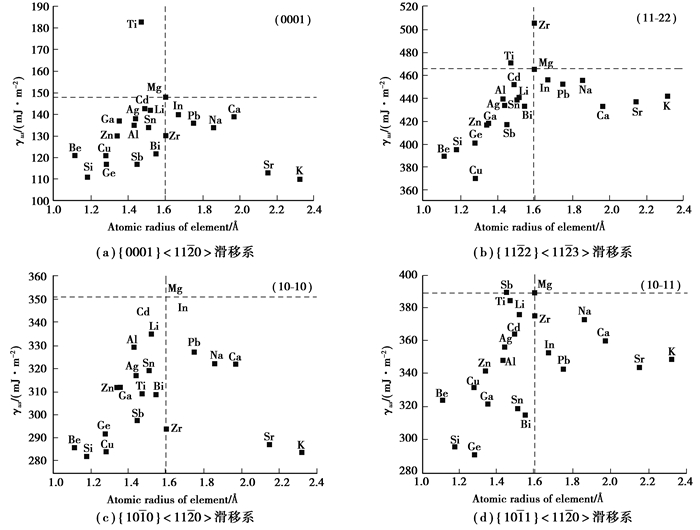
|
图 7 Mg47X1的广义层错能[88] Figure 7 GSFE values for Mg47X1 against the atomic radius of alloying elements[88] |
合金相的脆韧性主要由Pugh判据来衡量的,固溶体的脆韧性则可通过延性参数D[89]判断,其定义为表面能与非稳定层错能的比值。Zhang等[90]计算了22种Mg-X二元镁合金的延性参数D,如图 8所示。D值越大则固溶体的韧性越好,由图 8可知,Er、Zn、Y、Nd和Gd等元素可显著提高镁固溶体的韧性。为了更直观地通过第一性原理计算了解材料的宏观力学性能,Zhou等[91]对Al、Li和Cd掺杂镁合金的应力-应变曲线进行了模拟。在对Mg-Al[92]、Mg-Zn和Mg-Al-Zn[93]的拉伸模拟中,研究者建立了应力应变关系,得到合金的理想抗拉强度。掺杂Al元素改善了镁合金界面的内聚力,而Mg和Al之间电子电荷密度的重新排列形成强共价键,因此,Al原子有效提高了Mg-Al合金的强度。需要指出的是,采用均匀分布的掺杂原子,比分散分布的原子具有更好的增强效力,这证明了均匀化热处理的必要性。

|
图 8 镁合金固溶体的延性参数 Figure 8 Ductility parameter of solid solution Mg based alloys |
本文回顾了镁合金合金相及固溶体的晶体结构、弹性常数、弹性模量及广义层错能等的第一性原理研究进展。第一性原理计算不仅能精确模拟合金相及固溶体的力学性质,还有助于深入理解镁合金塑性变形的微观机理。根据晶格常数可以反映晶体的结构状态,由此检验模型的正确性和计算的准确性。基于弹性常数可以验证合金相是否符合力学稳定性,并能够推导出体积模量、剪切模量、杨氏模量、泊松比和各向剪切异性因子等力学性质。对各滑移系的广义层错能的分析有助于深入理解镁合金的塑性变形机制。通过拉伸模拟能够在理论角度直观地了解镁合金的宏观力学性能。
目前,基于第一性原理方法的镁合金研究已有一定程度的发展。尽管对镁合金合金相和固溶体的力学性能都有不少探索,但目前的工作极少将这两个方面结合起来综合分析,因此,在相关文献很难见到同时考虑了基体相和合金相的镁合金第一性原理研究分析。此外,合金元素含量对镁合金固溶体性质与性能影响的研究较少,且镁合金固溶体的第一性原理研究范围几乎为二元体系,极少涉及多元镁合金体系,这与实验研究存在巨大的差距。另一方面,第一性原理计算方法研究镁合金通常是模拟0 K条件下的材料性质及力学性能等,这与实际工作温度下的镁合金性质及力学性能等特征有所差异。因此,采用第一性原理方法研究镁合金仍有广阔的探索空间。未来的镁合金第一性原理研究工作可从以下工作入手。首先,将合金相与固溶体的第一性原理研究相结合,使其形成一个完整的体系并加以完善。其次,在以定性为主的镁合金固溶体第一性原理研究的基础上,考虑改变掺杂原子的含量,丰富镁合金固溶体性质和力学性能的定量研究。另外,为更好地模拟实际工作环境中镁合金的性能特征,需要在第一性原理计算中加入温度条件。最后,将第一性原理计算方法与分子动力学方法相结合,有利于拓展镁合金的计算模拟研究。综上所述,镁合金的第一性原理研究对新型镁合金成分设计及开发高性能镁合金具有重要的理论价值和指导意义,对镁合金的设计开发与广泛应用具有推动作用。
| [1] |
Chen Y, Xu Z, Smith C, et al. Recent advances on the development of magnesium alloys for biodegradable implants[J]. Acta Biomater, 2014, 10(11): 4561-4573. |
| [2] |
Chen X, Geng Y, Pan F. Research progress in magnesium alloys as functional materials[J]. Rare Metal Materials and Engineering, 2016, 45(9): 2269-2274. |
| [3] |
Zhang H, Zheng X, Tian X, et al. New approaches for rare earth-magnesium based hydrogen storage alloys[J]. Progress in natural science:Materials international, 2017, 27(1): 50-57. |
| [4] |
Li Q, Liu W, Song X. Research progress of Mg-Re alloys[J]. Advanced Materials Research, 2014, 937: 178-181. |
| [5] |
Ali Y, Qiu D, Jiang B, et al. Current research progress in grain refinement of cast magnesium alloys:A review article[J]. Journal of Alloys and Compounds, 2015, 619: 639-651. |
| [6] |
Alaneme K K, Okotete E A. Enhancing plastic deformability of Mg and its alloys:A review of traditional and nascent developments[J]. Journal of Magnesium and Alloys, 2017, 5(4): 460-475. |
| [7] |
Schrödinger E. On the connection of Heisenberg-Born-Jordan's quantum mechanics with mine[J]. Annalen Der Physik, 1926, 79(8): 734-756. |
| [8] |
Heisenber G W. Quantum-theoretical reinterpretation of kinematic and mechanical connections[J]. Zeitschrift Für Physik, 1925(33): 879-893. |
| [9] |
Zhong Y, Yang M, Liu Z K. Contribution of first-principles energetics to Al-Mg thermodynamic modeling[J]. Calphad, 2005, 29(4): 303-311. |
| [10] |
Wang J, Li X, Liu D, et al. The investigation on a universal local structural feature in Mg-Al alloys[J]. Computational Materials Science, 2017, 140: 224-234. |
| [11] |
Huang Z W, Zhao Y H, Hou H, et al. Electronic structural, elastic properties and thermodynamics of Mg17Al12, Mg2Si and Al2Y phases from first-principles calculations[J]. Physica B:Condensed Matter, 2012, 407(7): 1075-1081. |
| [12] |
Ozisik H, Deligoz E, Colakoglu K, et al. The first principles studies of the MgB7 compound:hard material[J]. Intermetallics, 2013, 39: 84-88. |
| [13] |
Zhang H, Shang S, Saal J E, et al. Enthalpies of formation of magnesium compounds from first-principles calculations[J]. Intermetallics, 2009, 17(11): 878-885. |
| [14] |
Wang H, Jin H, Chu W, et al. Thermodynamic properties of Mg2Si and Mg2Ge investigated by first principles method[J]. Journal of Alloys and Compounds, 2010, 499(1): 68-74. |
| [15] |
Zhou D, Liu J, Xu S, et al. Thermal stability and elastic properties of Mg2X (X=Si, Ge, Sn, Pb) phases from first-principle calculations[J]. Computational Materials Science, 2012, 51(1): 409-414. |
| [16] |
Wu D H, Wang H C, Wei L T, et al. First-principles study of structural stability and elastic properties of MgPd3 and its hydride[J]. Journal of Magnesium and Alloys, 2014, 2(2): 165-174. |
| [17] |
Deng Y H, Wang T F, Zhang W B, et al. Crystal structure of Mg3Pd from first-principles calculations[J]. Transactions of Nonferrous Metals Society of China, 2008, 18(2): 416-420. |
| [18] |
Tani J I, Takahashi M, Kido H. Lattice dynamics and elastic properties of Mg3As2 and Mg3Sb2 compounds from first-principles calculations[J]. Physica B:Condensed Matter, 2010, 405(19): 4219-4225. |
| [19] |
Drief F, Tadger A, Mesri D, et al. First principles study of structural, electronic, elastic and optical properties of MgS, MgSe and MgTe[J]. Catalysis Today, 2004, 89(3): 343-355. |
| [20] |
Zhou P, Gong H R. Phase stability, mechanical property, and electronic structure of an Mg-Ca system[J]. Journal of the Mechanical Behavior of Biomedical Materials, 2012, 8: 154-164. |
| [21] |
Zhong Y, Sofo J O, Luo A A, et al. Thermodynamics modeling of the Mg-Sr and Ca-Mg-Sr systems[J]. Journal of Alloys and Compounds, 2006, 421(1/2): 172-178. |
| [22] |
Ganeshan S, Shang S L, Zhang H, et al. Elastic constants of binary Mg compounds from first-principles calculations[J]. Intermetallics, 2009, 17(5): 313-318. |
| [23] |
Zhang J, Mao C, Long C G, et al. Phase stability, elastic properties and electronic structures of Mg-Y intermetallics from first-principles calculations[J]. Journal of Magnesium and Alloys, 2015, 3(2): 127-133. |
| [24] |
Wang Y F, Zhang W B, Wang Z Z, et al. First-principles study of structural stabilities and electronic characteristics of Mg-La intermetallic compounds[J]. Computational Materials Science, 2007, 41(1): 78-85. |
| [25] |
Zhou D W, Peng P, Liu J S. Electronic structure and stability of Mg-Ce intermetallic compounds from first-principles calculations[J]. Journal of Alloys and Compounds, 2007, 428(1/2): 316-321. |
| [26] |
Ullah N, Murtaza G, Khenata R, et al. Structural, chemical bonding and optoelectronic properties of Mg doped zinc chalcogenides:A first principles study[J]. Materials Science in Semiconductor Processing, 2014, 26: 681-689. |
| [27] |
Wang C, Han P D, Zhang L, et al. First-principles study on the stabilities of the intermetallic compounds in Mg-Nd aalloys[J]. Rare Metal Materials and Engineering, 2011, 40(4): 590-594. |
| [28] |
Peng C, Li D, Zeng X, et al. First principles investigation of β'-short and β'-long in Mg-Gd alloy[J]. Journal of Alloys and Compounds, 2016, 671: 177-183. |
| [29] |
Mogulkoc Y, Ciftci Y O, Kabak M, et al. Ab initio study of the structural, elastic, thermodynamic, electronic and vibration properties of TbMg intermetallic compound[J]. Superlattices and Microstructures, 2014, 71: 46-61. |
| [30] |
Mao P L, Yu B, Liu Z, et al. Mechanical properties and electronic structures of MgCu2, Mg2Ca and MgZn2 Laves phases by first principles calculations[J]. Transactions of Nonferrous Metals Society of China, 2014, 24(9): 2920-2929. |
| [31] |
Pavlic O, Ibarra-Hernandez W, Valencia-Jaime I, et al. Design of Mg alloys:The effects of Li concentration on the structure and elastic properties in the Mg-Li binary system by first principles calculations[J]. Journal of Alloys and Compounds, 2017, 691: 15-25. |
| [32] |
Yu W Y, Wang N, Xiao X B, et al. First-principles investigation of the binary AB2 type Laves phase in Mg-Al-Ca alloy:Electronic structure and elastic properties[J]. Solid State Sciences, 2009, 11(8): 1400-1407. |
| [33] |
Wu M M, Wen L, Tang BY, et al. First-principles study of elastic and electronic properties of MgZn2 and ScZn2 phases in Mg-Sc-Zn alloy[J]. Journal of Alloys and Compounds, 2010, 506(1): 412-417. |
| [34] |
Zhou D, Liu J, Xu S, et al. First-principles investigation of the binary intermetallics in Mg-Al-Sr alloy:Stability, elastic properties and electronic structure[J]. Computational Materials Science, 2014, 86: 24-29. |
| [35] |
Zhou D W, Liu J S, et al. A first-principles study on electronic structure and elastic properties of Al4Sr, Mg2Sr and Mg23Sr6 phases[J]. Transactions of Nonferrous Metals Society of China, 2011, 21(12): 2677-2683. |
| [36] |
Wang F, Sun S J, Yu B, et al. First principles investigation of binary intermetallics in Mg-Al-Ca-Sn alloy:Stability, electronic structures, elastic properties and thermodynamic properties[J]. Transactions of Nonferrous Metals Society of China, 2016, 26(1): 203-212. |
| [37] |
Mao P, Yu B, Liu Z, et al. First-principles calculations of structural, elastic and electronic properties of AB2 type intermetallics in Mg-Zn-Ca-Cu alloy[J]. Journal of Magnesium and Alloys, 2013, 1(3): 256-262. |
| [38] |
Chen G, Zhang P. First-principles study of electronic structures, elastic properties and thermodynamics of the binary intermetallics in Mg-Zn-Re-Zr alloy[J]. Defence Technology, 2013, 9(3): 131-139. |
| [39] |
Ali S F, Arab F, Zerroug S, et al. First-principles study of structural and elastic properties of MgSe under hydrostatic pressure[J]. Computational Materials Science, 2008, 41(4): 538-541. |
| [40] |
Tao X, Ouyang Y, Liu H, et al. Elastic constants of B2-MgRE (RE=Sc, Y, La-Lu) calculated with first-principles[J]. Solid State Communications, 2008, 148(7/8): 314-318. |
| [41] |
Tang P Y, Wen L, Tong Z F, et al. Stacking faults in B2-structured magnesium alloys from first principles calculations[J]. Computational Materials Science, 2011, 50(11): 3198-3207. |
| [42] |
Wang R, Wang S, Yao Y, et al. The temperature-dependent elastic properties of B2-MgRE intermetallic compounds from first principles[J]. Physica B:Condensed Matter, 2012, 407(1): 96-102. |
| [43] |
Uǧur Ş, Uǧur G, Soyalp F, et al. First-principles study of B2-like intermetallics LaMg and YMg[J]. Intermetallics, 2012, 22: 218-225. |
| [44] |
Zhong Y, Ozturk K, Sofo J O, et al. Contribution of first-principles energetics to the Ca-Mg thermodynamic modeling[J]. Journal of Alloys and Compounds, 2006, 420(1/2): 98-106. |
| [45] |
Tang B Y, Yu W Y, Zeng X Q, et al. First-principles study of the electronic structure and mechanical properties of CaMg2 Laves phase[J]. Materials Science and Engineering:A, 2008, 489(1/2): 444-450. |
| [46] |
Wu M M, Jiang Y, Wang J W, et al. Structural, elastic and electronic properties of Mg(Cu1-xZnx)2 alloys calculated by first-principles[J]. Journal of Alloys and Compounds, 2011, 509(6): 2885-2890. |
| [47] |
Mao P, Yu B, Liu Z, et al. Mechanical, electronic and thermodynamic properties of Mg2Ca Laves phase under high pressure:A first-principles calculation[J]. Computational Materials Science, 2014(88): 61-70. |
| [48] |
Yu F, Sun J X, Chen T H. High-pressure phase transitions of Mg2Ge and Mg2Sn:First-principles calculations[J]. Physica B:Condensed Matter, 2011, 406(9): 1789-1794. |
| [49] |
Li C, Zhang K, Ru J G. Pressure dependence of structural, elastic and electronic of Mg2Y:A first principles study[J]. Journal of Alloys and Compounds, 2015, 647: 573-577. |
| [50] |
Liu Y, Hu W C, Li D J, et al. Structural, electronic and thermodynamic properties of BiF3-type Mg3Gd compound:A first-principle study[J]. Physica B:Condensed Matter, 2014, 432: 33-39. |
| [51] |
Luo T P, Ma L, Pan R K, et al. Structural and elastic properties of La2Mg17 from first-principles calculations[J]. Journal of Solid State Chemistry, 2013, 206: 272-276. |
| [52] |
Zhang X, Ying C, Jiang W, et al. First-principle study of the physics properties of DO3-Mg3Nd compound under high pressure[J]. Superlattices and Microstructures, 2014, 73: 359-369. |
| [53] |
Aǧduk S, Gökoǧlu G. High-pressure elasticity and lattice dynamics of Mg2La from first principles[J]. Journal of Alloys and Compounds, 2012, 520: 93-97. |
| [54] |
Mattesini M, Ahuja R, Johansson B. Cubic Hf3N4 and Zr3N4:A class of hard materials[J]. Physical Review B, 2003, 68(18). |
| [55] |
Patil S K R, Khare S V, Tuttle B R, et al. Mechanical stability of possible structures of PtN investigated using first-principles calculations[J]. Physical Review B, 2006, 73(10). |
| [56] |
Wu Z J, Zhao E J, Xiang H P, et al. Crystal structures and elastic properties of superhard IrN2 and IrN3 from first principles[J]. Physical Review B, 2007, 76(5). |
| [57] |
Liu Y, Ren H, Hu W C, et al. First-principles calculations of strengthening compounds in magnesium alloy:A general review[J]. Journal of Materials Science & Technology, 2016, 32(12): 1222-1231. |
| [58] |
Ozisik H, Deligoz E, Colakoglu K, et al. Structural and mechanical stability of rare-earth diborides[J]. Chinese Physics B, 2013, 22(4): 046202. |
| [59] |
Liu D, Dai X, Wen X, et al. Predictions on the compositions, structures, and mechanical properties of intermediate phases in binary Mg-X (X=Sn, Y, Sc, Ag) alloys[J]. Computational Materials Science, 2015, 106: 180-187. |
| [60] |
Yang X, Hou H, Zhao Y, et al. First-principles investigation of the structural, electronic and elastic properties of MgxAl4-xSr (x=0, 0.5, 1) phases[J]. Computational Materials Science, 2014, 84: 374-380. |
| [61] |
Hu Q, Yang R. Mechanical properties of structural materials from first-principles[J]. Current Opinion in Solid State and Materials Science, 2006, 10(1): 19-25. |
| [62] |
Puge S F. Relations between the elastic moduli and the plastic properties of polycrystalline pure metals[J]. The London, Edinburgh, and Dublin Philosophical Magazine and Journal of Science, 1954, 45(7): 823-843. |
| [63] |
Counts W A, Friák M, Raabe D, et al. Using ab initio calculations in designing bcc Mg-Li alloys for ultra-lightweight applications[J]. Acta Materialia, 2009, 57(1): 69-76. |
| [64] |
Dai J, Song Y, Yang R. Influences of alloying elements and oxygen on the stability and elastic properties of Mg17Al12[J]. Journal of Alloys and Compounds, 2014, 595: 142-147. |
| [65] |
King W F, Cutler P H. A first principle calculation of the total binding energy and c/a ratio of magnesium[J]. Physics Letters A, 1970, 32(6): 395-396. |
| [66] |
Smith A E. Surface, interface and stacking fault energies of magnesium from first principles calculations[J]. Surface Science, 2007, 601(24): 5762-5765. |
| [67] |
Ganeshan S, Shang S L, Wang Y, et al. Effect of alloying elements on the elastic properties of Mg from first-principles calculations[J]. Acta Materialia, 2009, 57(13): 3876-3884. |
| [68] |
Datta A, Waghmare U V, Ramamurty U. Structure and stacking faults in layered Mg-Zn-Y alloys:A first-principles study[J]. Acta Materialia, 2008, 56(11): 2531-2539. |
| [69] |
Peng Q, Meng J, Li Y, et al. Effect of yttrium addition on lattice parameter, Young's modulus and vacancy of magnesium[J]. Materials Science and Engineering:A, 2011, 528(4/5): 2106-2109. |
| [70] |
Cui R, Wang X, Dong Z, et al. First principles study on elastic and thermodynamic properties of Mg1-xZnx alloy[J]. Acta Metallurgica Sinica, 2017, 53(9): 1133-1139. |
| [71] |
Dai J H, Wu X, Song Y. Influence of alloying elements on phase stability and elastic properties of aluminum and magnesium studied by first principles[J]. Computational Materials Science, 2013, 74: 86-91. |
| [72] |
Velikokhatnyi O I, Kumta P N. First principles study of the elastic properties of magnesium and iron based bio-resorbable alloys[J]. Materials Science and Engineering:B, 2018, 230: 20-23. |
| [73] |
Tane M, Kimizuka H, Hagihara K, et al. Effects of stacking sequence and short-range ordering of solute atoms on elastic properties of Mg-Zn-Y alloys with long-period stacking ordered structures[J]. Acta Materialia, 2015, 96: 170-188. |
| [74] |
Tane M, Nagai Y, Kimizuka H, et al. Elastic properties of an Mg-Zn-Y alloy single crystal with a long-period stacking-ordered structure[J]. Acta Materialia, 2013, 61(17): 6338-6351. |
| [75] |
Ravindran P, Fast L, Korzhavyi P A, et al. Density functional theory for calculation of elastic properties of orthorhombic crystals:Application to TiSi2[J]. Journal of Applied Physics, 1968, 84(9): 4891-4904. |
| [76] |
Wu X, Wang R, Wang S. Generalized-stacking-fault energy and surface properties for HCP metals:A first-principles study[J]. Applied Surface Science, 2010, 256(11): 3409-3412. |
| [77] |
Fan T W, Tang B Y, Peng L M, et al. First-principles study of long-period stacking ordered-like multi-stacking fault structures in pure magnesium[J]. Scripta Materialia, 2011, 64(10): 942-945. |
| [78] |
Li F, Wu X, Wang R, et al. The transformation pathways for vitual long period stacking-ordered Mg:First-principles study[J]. Computational Materials Science, 2016, 114: 1-12. |
| [79] |
Han J, Su X M, Jin Z H, et al. Basal-plane stacking-fault energies of Mg:A first-principles study of Li-and Al-alloying effects[J]. Scripta Materialia, 2011, 64(8): 693-696. |
| [80] |
Wang H Y, Zhang N, Wang C, et al. First-principles study of the generalized stacking fault energy in Mg-3Al-3Sn alloy[J]. Scripta Materialia, 2011, 65(8): 723-726. |
| [81] |
Zhang H Y, Wang H Y, Wang C, et al. First-principles calculations of generalized stacking fault energy in Mg alloys with Sn, Pb and Sn+Pb dopings[J]. Materials Science and Engineering:A, 2013, 584: 82-87. |
| [82] |
Yasi Ja, Hector L G, Trinkle D R. Prediction of thermal cross-slip stress in magnesium alloys from a geometric interaction model[J]. Acta Materialia, 2012, 60(5): 2350-2358. |
| [83] |
Zhang Q, Fu L, Fan T W, et al. Ab initio study of the effect of solute atoms Zn and Y on stacking faults in Mg solid solution[J]. Physica B-Condensed Matter, 2013, 416: 39-44. |
| [84] |
Sandlöbes S, Friák M, Zaefferer S, et al. The relation between ductility and stacking fault energies in Mg and Mg-Y alloys[J]. Acta Materialia, 2012, 60(6/7): 3011-3021. |
| [85] |
Cui X Y, Yen H W, Zhu S Q, et al. On the universality of Suzuki segregation in binary Mg alloys from first principles[J]. Journal of Alloys and Compounds, 2015, 620: 38-41. |
| [86] |
Dong Q, Luo Z, Zhu H, et al. Basal-plane stacking-fault energies of Mg alloys:A first-principles study of metallic alloying effects[J]. Journal of Materials Science & Technology, 2018. |
| [87] |
Zhang J, Dou Y, Liu G, et al. First-principles study of stacking fault energies in Mg-based binary alloys[J]. Computational Materials Science, 2013, 79: 564-569. |
| [88] |
Wang C, Zhang H Y, Wang H Y, et al. Effects of doping atoms on the generalized stacking-fault energies of Mg alloys from first-principles calculations[J]. Scripta Materialia, 2013, 69(6): 445-448. |
| [89] |
Rice J R. Dislocation nucleation from a crack tip:an analysis based on the Peierls concept[J]. Journal of the Mechanics and Physics of Solids, 1992, 40(2): 239-271. |
| [90] |
Zhang J, Dou Y, Dong H. Intrinsic ductility of Mg-based binary alloys:A first-principles study[J]. Scripta Materialia, 2014, 89: 13-16. |
| [91] |
Zhou L, Su K, Wang Y, et al. First-principles study of the properties of Li, Al and Cd doped Mg alloys[J]. Journal of Alloys and Compounds, 2014, 596: 63-68. |
| [92] |
Wang C, Han P, Zhang L, et al. The strengthening effect of Al atoms into Mg-Al alloy:A first-principles study[J]. Journal of Alloys and Compounds, 2009, 482(1/2): 540-543. |
| [93] |
Wang C, Huang T L, Wang H Y, et al. Effects of distributions of Al, Zn and Al+Zn atoms on the strengthening potency of Mg alloys:A first-principles calculations[J]. Computational Materials Science, 2015, 104: 23-28. |
 2018, Vol. 41
2018, Vol. 41


